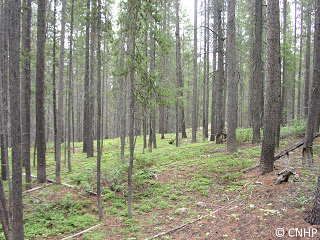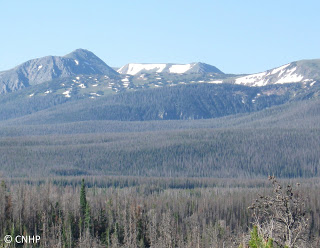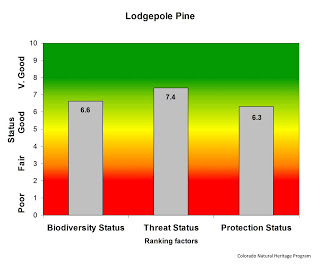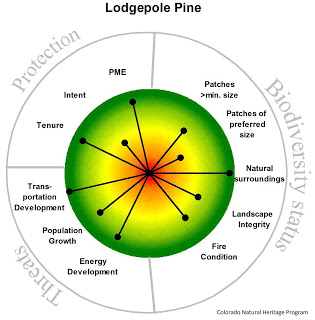In Colorado, the lodgepole pine ecological system is widespread between 8,000-10,000 feet in elevation, on gentle to steep slopes of the Rocky Mountains in the northern part of the state. Stands may be pure lodgepole pine, or mixed with other conifer species. Following stand-replacing fires, lodgepole pine rapidly colonizes and develops into dense, even-aged stands (sometimes referred to as “dog hair” stands). Lodgepole pine forests typically have shrub, grass, or barren understories, sometimes intermingled with aspen. Shrub and groundcover layers are often sparse in lodgepole pine forests. Diversity of plant species is also low, perhaps as a result of the uniform age and dense canopy of many stands.
Lodgepole forests cover more than two million acres in Colorado. Although these forests are common across Colorado, most are experiencing widespread damage from a severe outbreak of mountain pine beetle. The pine beetle is a native species, and periodic outbreaks of this insect are part of the natural cycle that maintains our mountain forests. Climate change, however, may enhance the scope and severity of the outbreaks.
Lodgepole pine stands hit by the mountain pine beetle.
Common mammal species in these forests include the pine squirrel (also called chickaree), porcupine, mule deer, and elk. Typical birds are the Mountain Chickadee, Pine Siskin, Ruby-crowned Kinglet, and Yellow-rumped Warbler. Rarer species include the Three-toed Woodpecker and Williamson’s Sapsucker. These forests are used occasionally by lynx.
A porcupine contemplating the status of lodgepole forests.
Most of our lodgepole forests are on federally owned lands managed by the U.S. Forest Service, Bureau of Land Management, or National Park Service. Most are not completely within wilderness areas, although they may be present along the boundaries of these areas. Lodgepole pine forests in Colorado generally have good conservation status. Natural processes such as fire and pine beetle infestation are the most obvious impacts to these forests. Fire suppression and logging have affected some areas.
Overall biodiversity, threat, and protection status scores for lodgepole pine in Colorado.
A “windrose” graph depicting lodgepole status for individual scoring factors.









